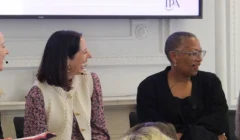
Protecting energy matters
At the IPA’s International Women’s Day Stepping into the Spotlight event industry leaders discuss the importance of protecting energy in polarising times.

With a safe, intentional approach AI will help augment our creativity, says Dr Rebecca Swift

Does anyone remember the metaverse? Remember that? 2023 truly has been the year of AI. A dizzying rollercoaster of a ride in which changes as profound as the Industrial Revolution have happened over weeks and months rather than decades.
I’ve been in the industry long enough to have witnessed a number of disruptors. The days of running physical photographic prints over to advertising agencies are a distant memory. Smartphone-shot, user-generated content became just another type of visuals to engage consumers with. With every disruption, our industry adapted.
So here we are again. Except this time it is different, with this technology impacting every industry and every individual and developing at the speed of light. We are right to be cautious. “Of course she would say that!” I hear you cry. But consider this – the creative industry accounts for 2.29 million jobs and generates £109 billion for the UK – that's something worth protecting. One of AI’s greatest potentials is that it can enhance creativity – but that will only happen if the rights of creatives are acknowledged from the outset. This fundamental is at the heart of how we at Getty Images have approached the technology and its possibilities.
One of AI’s greatest potentials is that it can enhance creativity – but that will only happen if the rights of creatives are acknowledged from the outset.
Dr Rebecca Swift, SVP Creative Content, Getty Images
As we all know, it’s those off the cuff conversations in which we share thoughts and observations person to person where the magic often happens. Beyond their training sets, generative AI tools have no knowledge of – nor experience of – what is going on in the world. It can only access what has been, not react to the present or future – or indeed consider how people currently feel about a brand or product.
Authenticity has also come into sharp focus as a key component of trust in this new era of AI. According to our VisualGPS research people define ‘authentic’ as ‘real/the real thing’, followed by ‘true/truthful’ and ‘original’ and 98% of consumers agree that 'authentic' images and videos are pivotal in establishing trust. Essentially, no one wants to feel hoodwinked. This is consistent with the huge response we’ve seen to our collections #ShowUs, The Disability Collection and The Disrupt Ageing Collection - all of which have authenticity baked into them, either informed by or created by the people they represent. Knowing this, I think it’s fair to say that in the incoming tide of generative AI tools and content, thoughtfully crafted ideas by expert creatives will cut through and engage audiences more than ever.
Time to get creative! This technology allows marketers and creatives to produce images that would otherwise be hard to create – such as a penguin standing on a road in the middle of a city, or a truck suspended in the sky, or how about a puppy coming out of the clouds? Let your imagination run wild.
The tool is also great to use for playing around and visualising hard to represent topics and concepts. Have some fun prompting around conceptual landscapes, futuristic green cities or realistic animals in unusual settings. Test out your prompting skills around specific textures and colour palettes to create something which will make your brand stand out from the crowd. One of my personal favourites from what our creatives have created is visualising surreal, zen spaces which come up with rich colour palettes, lush surroundings and interesting textures and shapes. The opportunities are endless.
Take an intentional approach to why, when and how you use generative AI visuals within a brand campaign. For example, ask yourself, what is the campaign message and are generative AI visuals the right content to use in this instance. If, for example, the campaign is speaking to authenticity or your audience cares about representation – real people and real connections – I would argue it’s not. It’s about staying authentic to the relationship between brand and customer, establishing or reinforcing trust.
Generative AI is a powerful tool and new technologies have never hindered creativity in the past. Photography didn't put an end to painting but sparked new artistic movements. The electric guitar paved the way for rock and roll. At Getty Images we are excited about how commercially safe generative AI image making in your hands could lead to some of the most creative client work we’ve ever seen. AI will undoubtedly change the way we work, but I think it will do so for the better, facilitating creativity in new ways. With a safe, intentional approach and good quality tools, we can move on from worrying about how AI will steal our jobs to how AI will augment our creativity.
Dr Rebecca Swift directs the company’s creative insights and creation of imagery and video used in award-winning advertising, design and editorial around the world. Working closely with creators, art directors and creative researchers globally, Rebecca plays a critical role in ensuring that Getty Images is continually providing fresh, relevant creative content and insights, which in turn engages and inspires creatives and marketers around the world. Her foresight into cultural and societal trends that shape visual communications drives Getty Images’ creative offering. Rebecca joined the photography industry over 20 years ago and was one of the founding members of the creative research team at Getty Images, introducing visual research methodology to the industry. Rebecca has a PhD in Photography. Her research expertise is in commercial creativity and the evolution of visual trends in advertising.
Looks like you need to create a Creativebrief account to perform this action.
Create account Sign inLooks like you need to create a Creativebrief account to perform this action.
Create account Sign in